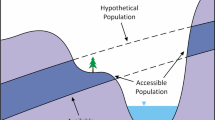Abstract
The important goals of mineral exploration geochemistry are detection and identification of underlying mineralization. This paper deals with element concentration data analyzed of surface geochemical samples acquired from soil horizons or plants. A new unsupervised procedure is proposed for this purpose when the samples have been taken on a regular or irregular grid in the area under investigation. The methodology is based on Generalized Additive Model fits on element concentration data. Then new data points are taken of the surface of the smooth fits across the entire sampling area as a regular grid. Pairwise log-ratios of elements are then calculated of these points, and curvature of the log-ratio pairs is computed. High curvature indicates abrupt spatial changes, which could point at locations of mineralized zones. A measure called c-value evaluates the overall curvature and thus serves as an importance measure of a log-ratio pair. The methodology is tested on two real surface geochemical data sets collected in areas with known underlying mineralization, and the results confirm existing knowledge of the underlying mineralization.








Similar content being viewed by others
References
Agnico Eagle (2015) Annual report. http://s1.q4cdn.com/150142668/files/doc_financials/2015/2015-Annual-Report.pdf
Cheng Q (2012) Singularity theory and methods for mapping geochemical anomalies caused by buried sources and for predicting undiscovered mineral deposits in covered areas. J Geochem Explor 122:55–70
Cleveland W, Grosse E, Shyu W (1992) Local regression models. In: Chambers J, Hastie T (eds) Statistical models in S. Wadsworth & Brooks/Cole, Pacific Grove, CA. Chapter 8
Dahooei H, Afzal P, Lotfi M, Jafarirad A (2016) Identification of mineralized zones in the Zardu area, Kushk SEDEX deposit (Central Iran), based on geological and multifractal modeling. Open Geosci 8:143–153
Darabi-Golestan F, Ghavami-Riabi R, Khalokakaie R, Asadi-Haroni H, Seyedrahimi-Nyaragh M (2013) Interpretation of lithogeochemical and geophysical data to identify the buried mineralized area in Cu–Au porphyry of Dalli-Northern Hill. Arab J Geosci 6(11):4499–4509
Do Carmo MP (2016) Differential geometry of curves and surfaces: revised and updated, 2nd edn. Courier Dover Publications, Mineola
Dunn C (2007) Biogeochemistry in mineral exploration, handbook of exploration and environmental geochemistry, vol 9. Elsevier, Amsterdam
Fomenko AT, Tuzhilin AA (2005) Elements of the geometry and topology of minimal surfaces in three-dimensional space, vol 93. American Mathematical Soc, Providence
Geological Survey of Finland (2020) Mineral deposit report, electronic resource available at. http://tupa.gtk.fi/karttasovellus/mdae/raportti/387_Kuotko.pdf
Goldman R (2005) Curvature formulas for implicit curves and surfaces. Comput Aided Geom Des 22(7):632–658
Härkönen I, Pankka H, Rossi S (2000) Summary report: the Iso-Kuotko gold prospects, northern Finland. Technical report report no. C/M06/2744/00/1/10, Geological Survey of Finland (GTK)
Kahle D, Wickham H (2013) ggmap: spatial visualization with ggplot2. R J 5(1):144–161
Mert M, Filzmoser P, Hron K (2016) Error propagation in isometric logratio coordinates for compositional data: theoretical and practical considerations. Math Geosci 48(8):941–961
Mikšová D, Rieser C, Filzmoser P (2019) Identification of mineralization in geochemistry along a transect based on the spatial curvature of log-ratios. arXiv:1912.02867
Mikšová D, Rieser C, Filzmoser P, Thaarup S, Melleton J (2020) A method to identify geochemical mineralization on linear transect. arXiv:2003.10268
Molnár F, Middleton A, Stein H, O’Brien H, Lahaye Y, Huhma H, Pakkanen L, Johanson B (2018) Repeated syn- and post-orogenic gold mineralization events between 1.92 and 1.76 Ga along the Kiistala Shear Zone in the Central Lapland Greenstone Belt, northern Finland. Ore Geol Rev 101:936–959
Roshani P, Mokhtari A, Tabatabaei S (2013) Objective based geochemical anomaly detection-Application of discriminant function analysis in anomaly delineation in the Kuh Panj porphyry Cu mineralization (Iran). J Geochem Explor 130:65–73
Taivalkoski A, Torppa J, Mikšová D, Middleton M, Sarala P (2019) Ultra low-impact exploration methods in the subarctic (UltraLIM) project: the analytical data of the soil samples processed with R
Torppa J, Middleton M (2017) Biogeochemical data analysis methods and R implementation in the UltraLIM project. Geological Survey of Finland, GTK archive report 8/2017
Webster R, Lark M (2012) Field sampling for environmental science and management. Routledge, London
Wood S (2017) Generalized additive models: an introduction with R. Chapman and Hall/CRC, Boca Raton
Wood SN, Bravington MV, Hedley SL (2008) Soap film smoothing. J R Stat Soc Ser B (Stat Methodol) 70(5):931–955
Zuo R (2017) Machine learning of mineralization-related geochemical anomalies: a review of potential methods. Nat Resour Res 26(4):457–464
Acknowledgements
The authors thank Jukka Va\(\ddot{\mathrm{l}}\)imaa and Jyrki Korteniemi (Agnico-Eagle Finland Ltd., Kittilä Mine, Finland) for allowing access to drill core geochemical data and plant sampling at Tiira, and Sami Lepistö and Tero Niiranen (Geological Survey of Finland, GTK) for 3D and lithogeochemical expertise. Päivi Heikkilä, Matti Piekkari, Petro Oravalahti and Markku Virtanen (GTK) performed the plant sampling and sample preparation. The sample collection and analytics was funded by the GTK project Postglacial faults (# 50402-20086, 2016–2019). Many thanks go to Simon M. Thaarup and Anders Risbjerg (Geological Survey of Denmark and Greenland, GEUS), for the sample collection and useful information related to data analytics. This activity received funding from the European Institute of Innovation and Technology (EIT), a body of the European Union, under the Horizon 2020, the EU Framework Programme for Research and Innovation. Data analyses was funded by the EIT Raw Materials project UpDeep - Upscaling deep buried geochemical exploration techniques into European business (2017–2020) (Grant No. 16329). This research of Christopher Rieser was supported by the Austrian Science Fund (FWF) under the Grant No. P 32819 Einzelprojekte.
Author information
Authors and Affiliations
Corresponding author
Rights and permissions
About this article
Cite this article
Mikšová, D., Rieser, C., Filzmoser, P. et al. Identification of Mineralization in Geochemistry for Grid Sampling Using Generalized Additive Models. Math Geosci 53, 1861–1880 (2021). https://doi.org/10.1007/s11004-021-09929-x
Received:
Accepted:
Published:
Issue Date:
DOI: https://doi.org/10.1007/s11004-021-09929-x




